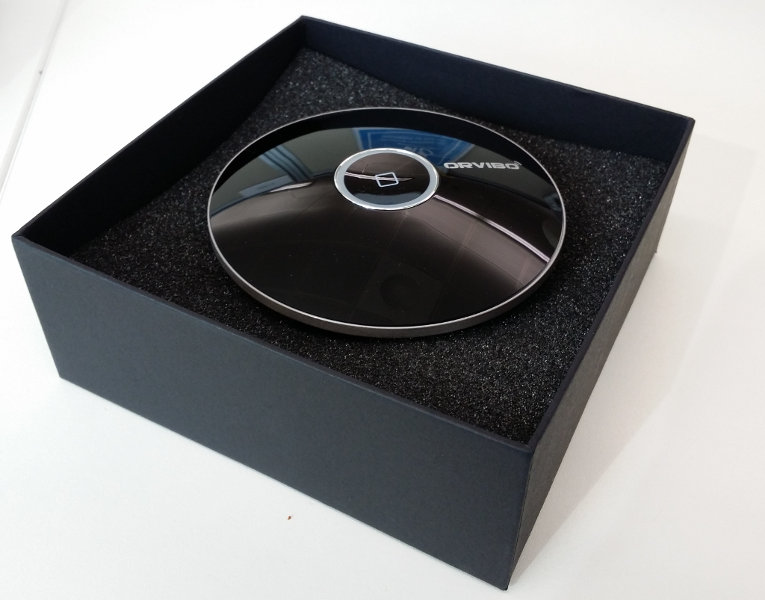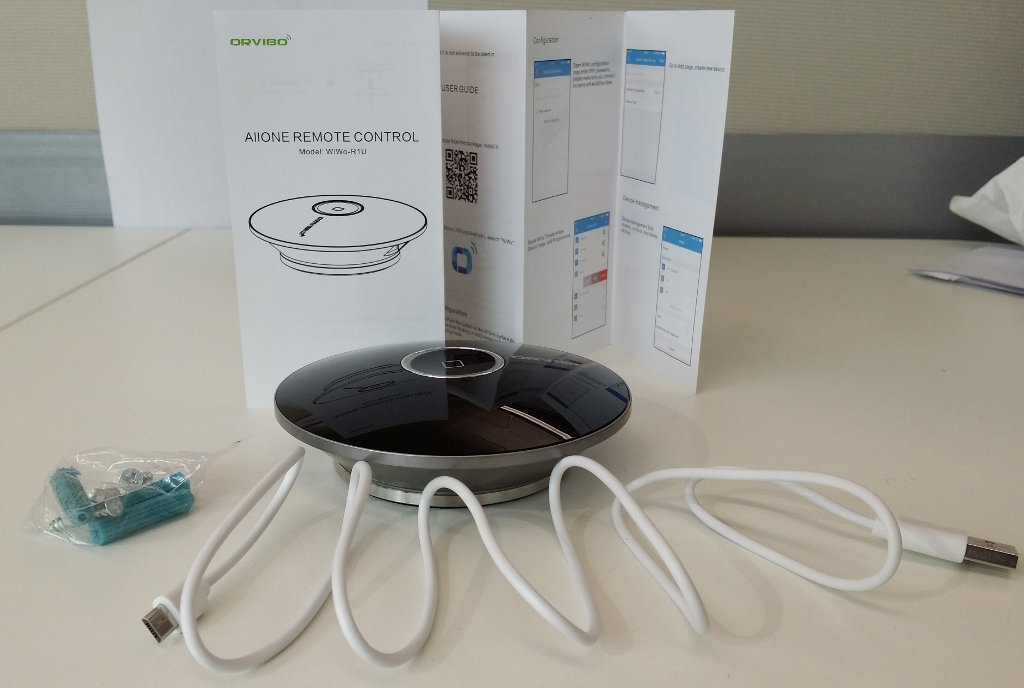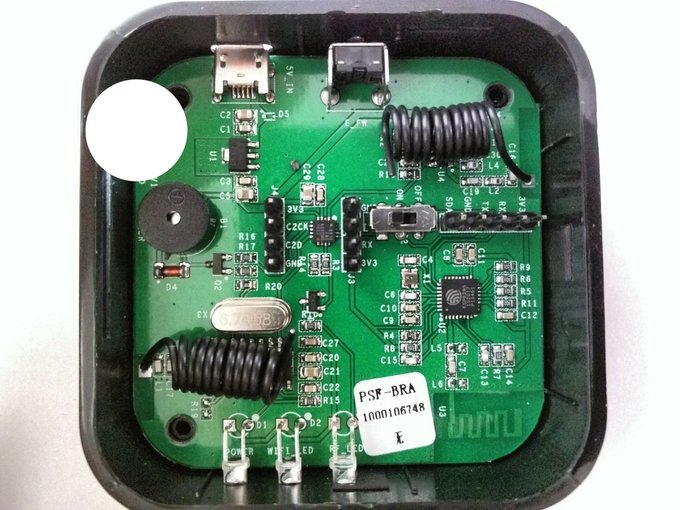Review: Gearbest Orvibo Smart Remote
In the glorious future, every device you own will have WiFi connectivity. With a tap on your app, you'll be able to switch on your TV, dim your lights, and set the air-conditioner to "frosty". We're not quite there yet - we live in a world where even the newest fangled kit relies on technology from the 1970.
Yes, I'm talking about Infra-Red. Good old IR has been around for ages - you're bound to have a few devices which rely on it.
The folks at Gearbest have sent me an Orvibo WiFi Smart Remote in exchange for an honest review. Its promise is pretty simple - control all your Infra-Red gadgets via your smartphone. So, how does it perform?
Unboxing
It's very well presented - glossy black finish, with a sturdy feel to it.

All the product shots of the device make it look like it would dominate a lounge table.

But the Shezen built device is surprisingly small - just 11cm in diameter and a whisker over 3cm tall.
In the box you get the device, a 1m long micro-USB charging cable, 3 screws and rawl-plugs (should you wish to attach it to a wall), and a (poorly translated) instruction manual.
It's an elegant piece of kit. Reminiscent of a UFO. The eerie blue light on top can't be dimmed or switched off - it just gently pulses - so you probably want to place it out of your eye-line.
There are multiple IR transmitters (more on that later), so it really shouldn't matter where you place it in relation to your devices.
The App
In order to set-up and control the device, you'll need the app on your smartphone. It's available for iOS and Android on the Google Play App Store. If you don't have Google Play, you can download the APK directly.
You can add new devices, set up custom remote controls, add scenes (press one button - have multiple commands sent to different devices), create schedules, and set up passwords.
The app suffers from a fairly poor translation to English - but seems easy enough to muddle through.
There a "Cloud Service" which claims to be able to back up your configurations. I couldn't get my phone to talk to the servers in China reliably. Sniffing the traffic showed that it all went via HTTP - so don't stick your garage door codes in there!
Really, the only thing the app is missing is a widget. It would be great to press a single button on my home screen and have my TV switch on and tune to the channel I like, while closing my blinds and turning on the AC.
Set Up
I'll admit - this is where I nearly came unstuck. According to the manual, I should plug the Orvibo AllOne into the power, then use the app to configure it. That didn't work.
I'm not sure what I was doing wrong, but I tried multiple Android handsets and tablets - nothing seemed to work. Eventually, I tried connecting it to a WiFi network which didn't have a password - and it worked straight away. I'm not sure if it didn't like my SSID, my password, or the WPA provided by Virgin Media. None of my other electronics have a problem with my home WiFi network.
Eventually, after using the AP configuration screen multiple times, I was able to get it to connect. A slightly frustrating experience but one which only needs to be completed once.
Use
Once set up, I was impressed by just how quickly everything worked. As soon as I pressed a button on my phone, the TV reacted. Here's a quick video:
(My camera catches the IR flashes - you don't see them in real life).
There are a wide range of remotes supported, all with unique layouts. They're fairly customisable and quick to access.
The app claims to be able to download TV remote control profiles - but I couldn't get this to work. Instead you have to set the Allone into learning mode, aim your regular remote control at it, then simultaneously hold down the relevant button in the app and press the same button on your remote. A little cumbersome, but it seems to work.
Hacking
Plugging the USB device into a computer doesn't reveal anything interesting - all it does is charge. A quick use of nmap didn't pick up anything interesting either. There's no web server, REST API, telnet, SSH, or anything useful for an easy hack.
Thanks to the Open Source community, we can stand on the shoulders of giants! There is a Node.js library for controlling the Orvibo AllOne. I'm not overly familiar with Node.js, but it's fairly clear that the interface for the device is based around sending UDP packets to port 10,000 on the device.
packetLength = _s.lpad(decimalToHexString(ir.length / 2 + 26).toString(), 4, "0"); // This takes the length of our whole packet (IR + 26 bytes) and converts it to hex. Uses _s to pad it with 0s to make it valid hex
irLength = _s.lpad(decimalToHexString(ir.length / 2).toString(), 4, "0"); // And we do the same, but with our hex
irLength = _s.chop(irLength,2).reverse().join(""); // Cut up our length into hex and reverse it (needed for the IR length. Strange..)
randomBitA = Math.floor((Math.random() * 2048)); // The A1 won't blast twice if this remains the same (some kind of accidental blast guard?), so get a random value
randomBitB = Math.floor((Math.random() * 2048)); // Same as above
payload = payload.concat(['0x68', '0x64'], this.hex2ba(packetLength), ['0x69', '0x63'], this.hex2ba(hosts[index].macaddress), twenties, ['0x65', '0x00', '0x00', '0x00'], randomBitA, randomBitB, this.hex2ba(irLength), this.hex2ba(ir)); // Put it all together
Not the easiest structure in the world - but should provide a solid basis for building libraries in other languages.
Cracking It Open
The metal base at the bottom twists off - revealing a single screw. Undo that, and the lid easily slips off.
 There are four IR transmitters around the circumference - they're the white squares. That's why this device can be placed in most locations - the beams scatter out in all directions.
There are four IR transmitters around the circumference - they're the white squares. That's why this device can be placed in most locations - the beams scatter out in all directions.
There's a single black IR receiver which is used for learning remote controls. I wasn't able to remove the tiny screws holding it all in place - but I assume the WiFi module is on the underside.
Judging by the MAC address, the WiFi module is the HF-LPB100.
Specifications & Other Notes
From the manufacturer's website:
Power supply: DC 5V 600mA Max current: 10A IR: 38 KHz FR: 433MHz ASK Material: High transmittance PC+stainless steel Wireless standard: Wi-Fi 2.4GHz b/g/n Wireless frequency: 2.412-2.484GHz Security type: WEP/TKIP/AES Security mechanism: WEP/WPA-PSK/WPA2-PSK Wireless consumption: less than 0.3W Working temperature: -20-60 Celsius Working humidity: less than 80 %
I don't have any 433MHz devices, so I was unable to test that.
After powering up the device, it connected to the WiFi within a few seconds. Although, weirdly, it kept changing IP address every-so often. I set the router to give it a static IP address.
Verdict
The Orvibo is very much a "stop-gap" technology. In an ideal world, all your tech would work over Bluetooth and WiFi. Until that day comes, being able to control older equipment via your phone is undeniably useful.
The price is decent considering what you get.
The Orvibo WiFi Smart Remote is available for £28.57 / €39.67 / $34.99.
Use the coupon code Allone to receive a discount, taking the price to £23.72 / €32.93 / $34.99.
This is a really useful device if you've got several IR devices that you don't want to upgrade.
It's let down by a complicated connection method and a poorly translated app. Although there's no official API, it does have a degree of hackability should you wish to experiment.
Overall, once it's on your WiFi, it's a solid and good looking device which does exactly what it promises.
The device was provided to me in exchange for an honest review.

 128 WiFi devices ought to be enough for anyone...
128 WiFi devices ought to be enough for anyone...
 Review: Sonoff 433 RF WiFi bridge
Review: Sonoff 433 RF WiFi bridge
Zena says:
Thank you for this article. It helped me make purchase decisions.
I just bought Orvibo's Allone and Socket (US).
Log in to your router from the cell phone and the configuration can happen quickly even with a password.
It was easy to configure the Allone for the TV & STB in learning mode. IR devices were also easy but I cannot get the system to recognize certain RF remotes. I have the Capstone Wireless Remote Control Outlets and Craftmade Remote for ceiling fans that the Allone fails to connect with.
Orvibo's website is written in Chinese. Any suggestions as to how we can provide direct feedback to Orvibo?
Zena
Zena says:
Right after I posted my comment, I found this email address support@orvibo.com and wrote to their tech support about a number of issues.
I forgot to mention their Time server is not calculating Pacific Time with Daylight Savings Time properly. The timer controls have to be set for 1 hour earlier than the clock shows.
Zena says:
The email to the above address was just returned. I'm back to looking for a way to contact tech support (English)
I'm the author of the node.js library, and you're right, UDP over port 10,000. Every product Orvibo makes uses the same sort of protocol, so that makes extending the code very easy.
I've re-written the library in golang (see it here: http://github.com/Grayda/go-orvibo). It supports the AllOne, the S10 / S20 WiFi smart sockets (basically a Chinese version of the Belkin WeMo) and in theory, the RF wall switches, though I don't own one, so I can't test that out.
In a few weeks, I should have Kepler support added in. Kepler is Orvibo's latest product, and is a WiFi gas detector. I'm buying a second hand unit from someone in the UK, so it might take a while to arrive.
Dear I need help
I have purchased one S20 and Allone from Orvibo . S20 has no problem in configuring with WiWo App but the Allone is not working at all. When trying to configure it with "Red Light Flashing" it tries for a minute (Countdown) and then gives failed error. Whereas in AP mode "Blue Light Flashing" it says AP time Out.
I am not at all familiar with coding or anthing but please please please help me in making it work Thanks.
Syed Shakil Amjid
Terence Eden says:
It sounds like it might be broken. You should return it to the retailer.
mvaneijgen says:
Have you ever came around and tested the RF 433 for universal use? I really want to buy this device, but I keep holding off because I don't know if I can control the RF 433 light switches that I already own.
Terence Eden says:
I haven't got any equipment which works with it. I suggest you buy it and write up your findings.
mvaneijgen says:
Hey, Thanks for your reply. There are to many sources online stating that it doesn't have a 'RF learn mode' and this will be the only thing I need this device for, so I will not buy it just to try with all indication that it will not work.
I'm currently dealing with the RF stuff as part of my node.js library rewrite, and as far as I can tell (I don't own the RF switches, just the AllOne), there is no RF learn mode. It seems like the 433mhz is solely to control their RF switches, and is only one way. The way I think it works, is like so:
You install the RF switch and set up the AllOne with your phone. You press and hold a button on the RF switch until it beeps. You go into WiWo (the app for the AllOne) and add a new light or switch device to your AllOne. This device is NOT stored on the AllOne -- it's stored on your phone. You go into the new switch you created in the app and press a button. The AllOne sends an RF message to the listening RF switch. Part of that message is an "RF ID" which ties that button you created in WiWo, to the RF switch.
I don't know how this RF ID is created (I'm still trying to work that out) so I don't know if you can create another switch in the WiWo app on another phone and control it. I highly doubt it, because part of the RF ID (as I understand it) changes each time you create a switch, but part of it stays the same.
So TL;DR: No, this thing doesn't have an RF learn mode and the RF is pretty much only good for their RF switches. Try the Broadlink RM2 Pro which definitely has RF learning mode (I hooked my doorbell up to it and rang it via the app, so it definitely learns and plays back!)
RobRoy says:
If you need BOTH IR and RF Control you could try the Broadlink RM Pro, (http://www.broadlink.com.cn/en/home-en.html.It) uses the "e-control app" on google play (https://play.google.com/store apps/details?id=com.broadlink.rmt&hl=en) and can be programmed with an IFTTT(If This Then That)type interface.It can learn RF(333 & 433MHz) and IR Codes and there are other Broadlink products like the S1(Security System) and A1(Air Quality,Temp,Humidity etc) that C1(IP Camera), WiFi switches and Plugs which work with it. Might be worth a Look?. Lots of info on it online(Just Google or YouTube "Broadlink".